This is a simple solution to the Rubik's Cube composed of various methods that I merged together that I felt was the easiest for beginners to learn. Some solutions require quite a bit of memorization and little thinking. Others require lots of thinking but little memorization. Others require lots of both but are extremely fast. The solution presented here falls on the low-thinking range, mild-memorization, but fairly-slow part of the spectrum. Therefore you will not be able to go off and solve a Rubik's Cube immediately after reading this page only once. That will require a good deal of memorization, but it's not impossible. I've seen people memorize this solution in a day. If you learn this solution thoroughly, your best time might be around a minute or a minute and a half. Once you get this method down pretty good, and you want to work on your solving time, I suggest you learn the Fridrich Method or another speed cubing method. Google is your friend.
Axioms To Keep In Mind:
- The cube consists of 21 individually moving parts. These include 1 triple-axis, 12 edge pieces, and 8 corner pieces.
- A center square will always remain a center square no matter how you turn the cube. An edge piece will always remain an edge piece no matter how you turn the cube.
- A corner piece will always remain a corner piece no matter how you turn the cube. Center pieces never change their position in relation to each other. They only twist around in place, even though it looks like they change places.
- An edge piece has two stickers on it. Those two stickers will always stay next to each other. If you want to move one of the colors to another position, the other has to come too. The same idea goes for corner pieces.
Peeling off the stickers is not the solution (in fact if you start to peel off some of the stickers but never finish putting the rest in their places, you are most likely going to cause an impossible combination and make the cube unsolvable). Even if you do finish replacing the stickers, you make solving the cube more difficult and awkward to a person who actually knows how to solve it since the colors are not in the same place in relation to each other.
A Side Note:
There is a difference between oriented and positioned. If a segment is in the wrong place, it is said to be in the wrong position. If a segment is in the right place but is facing the wrong way, then it is oriented incorrectly.
Step 1: Solving One Side
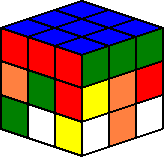
Solving the top row is the hardest part of the solution, believe it or not. Keep in mind that when you solve the one side, you have to solve the adjoining row at the same time. That means that if you decided to solve the blue face first, it would have to look something like the above picture. Notice how the red and green squares are all lined up nicely in the top row. Up to the challenge? Here we go...
Step-by-Step Instructions:
- Don't Panic
- Pick a color of the six (I will be using blue in most of the examples, so whenever I say blue, I really mean top color).
- Find a sticker of that color that is in the center of the face. This will be your top.
- Move the corresponding edge and corner pieces of that color next to the center cube while making sure the top outside row colors line up (may the thinking juices flow).
Let's break down that last part...
What you're basically trying to do is this:
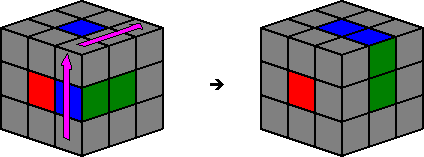
When you're trying to do this for the first time, it's always a good idea to solve the edge pieces first, so you have a cross on the top like this...
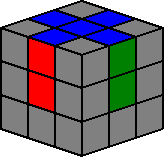
This will make positioning the corners easier.
However, sometimes you will get this little dilemma...
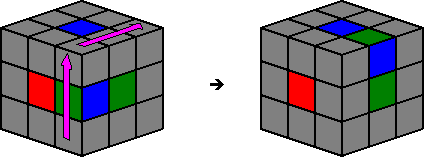
Here's what to do if that happens:





Click here for an animation of the above sequence.
When moving an edge piece to its place, make sure that while you're turning the sides it doesn't interfere with the edge pieces that are already in place. Move the top side so you can avoid messing up what you've done already.
Always remember to make sure that the colors on the side of the edge pieces line up with the other center squares (VERY IMPORTANT)...

Once you've got that down, you can move on to solving the corners.
If the corner you want to move is on the bottom row, move it directly underneath where you want it to go. Remember that the colors have to match up when it gets to the top row. So don't move a corner piece that has blue, yellow and orange on it directly underneath the blue-red and blue-green edge pieces.
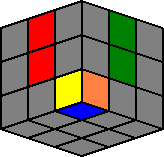
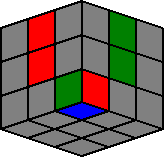
There are three ways to move this corner to the top row without disrupting any edge pieces. Depending on how the corner is oriented, you can decide how to move it.
The "2" means to turn that side 180 degrees. It doesn't matter which way.
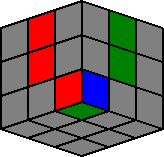 Blue sticker is facing right:
Blue sticker is facing right:




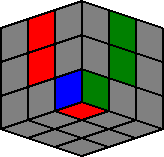 Blue sticker is facing left:
Blue sticker is facing left:




 Blue sticker is facing down:
Blue sticker is facing down:






What if the corner you need is on the top row already, but is in the wrong place or has the wrong orientation? Do this while holding the cube so that the desired corner is in front:




The piece you need is now on the bottom row somewhere to the left. Crisis Solved.
Look what you've just done:

Step 2: The Middle Row
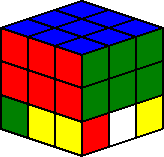
Now twist the top face so that the center cube on each adjoining face matches in color with the three squares above it so they make small T's on each side, like so.
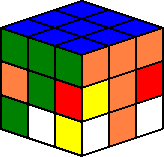
You can tell that an edge piece that has green on one side and orange on the other side goes in the middle of the picture above in order for it to look like this:
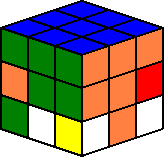
Look at the bottom face on your cube. Figure out what your bottom color will be; it should be the same color of the center sticker on the bottom.
Now look at the edge pieces on the bottom and try to find one that does not have the bottom color on it. That means that this edge piece should go in the middle row.
The next two algorithms show you how to move a piece from the bottom row to the middle row. Keep in mind that the colors given are only examples of what the color scheme on your cube could possibly look like. (red is front, green is right)
 →
→ 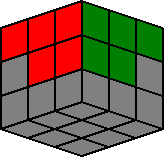









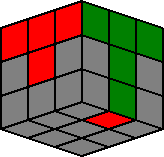 →
→ 









If a piece is in the middle row, but is not in the right place or is oriented incorrectly such as this red green edge...
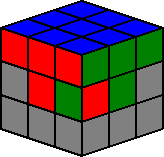
...then pick a random piece from the bottom row. Pretend that this random piece from the bottom row is the red green edge piece and solve it. Once you put this wrong piece in the red-green's spot, then the real red green piece will fall back to the bottom row. Once the real red green piece is in the bottom row, then you can position it in a normal fashion using the steps above.

Step 3: Orient Bottom Corners
This next step is one of the most commonly misinterpreted steps in the entire solution so pay careful attention...
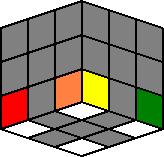
Next, you must orient the four corners. Compare the four corners on the bottom of your cube to these pictures. Disregard the non-corner pieces on the bottom of your cube. Skip this step if they are all oriented correctly. The whole point of comparing the bottom is to determine how to hold the cube for the next move. The black spots represent the bottom color of your cube. These are all the possible combinations of corner orientations. Figure out which one looks like the bottom corners on your cube. Now hold the cube so that it looks exactly like the way it does here. You may have to rotate it to get it to match.
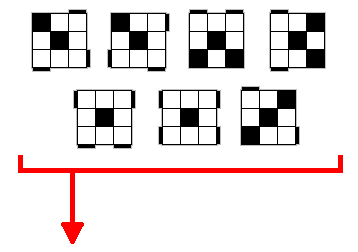








Note: Remember that '2' means turn the indicated face twice. It does not matter which direction you turn it. It'll end up the same either way.
Now go back to the beginning of this step and keep on doing this until all four corners are oriented properly. If you do it right, the most you should have to do this process is three times. Sometimes you'll get it on the first try. Sometimes you may get lucky and can skip this step altogether.
Getting there:
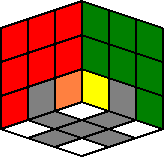
Step 4: Orient Bottom Edges
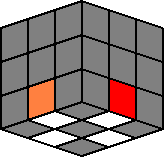
There are only 4 bottom edge orientation possibilities at this step. If your cube doesn't match one of these, then somebody's been peeling your stickers. This step's pretty simple. Ignore gray squares; white squares are the ones that need to be oriented. Hold the cube as you see it shown in the picture. If you don't hold it so that the white in the picture corresponds exactly to where disoriented edges are, you may do some moves destructive to your progress.
These moves are fairly simple to memorize because they always follow this pattern:
Left Up, Right Up, Turn the Front Somewhere,
Left Down, Right Down, Turn the Bottom Somewhere,
Repeat.
Peek underneath the cube to match it against one of the diagrams below. White squares represent edges that are not oriented correctly.
2 Wrong pieces next to each other
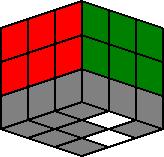







(The second half of this move is almost an exact repeat of the first!)





2 Wrong pieces across from each other
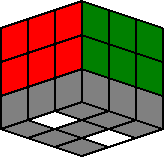


















All 4 edges are wrong
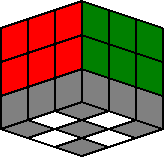


















Ever so close...
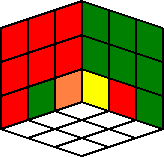
Step 5: Position Bottom Corners
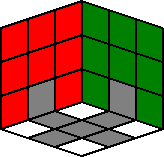
You can take a sigh of relief, as there is only 1 move to memorize in step 5.
This move will switch the places of the two corners in the bottom front without changing their orientation...
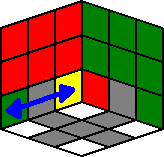











Continue using this move until all 4 corners are in the correct place. Edges still do not matter at this point.
Just One More Step To Go...

Step 6: Position Bottom Edges

Only 2 moves to memorize in this step. (But they're so similar it should only be counted as one)
These moves will rotate the following edge pieces...
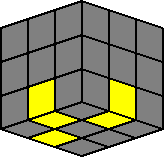
To rotate the yellow pieces clockwise...










To rotate the yellow pieces counter-clockwise...










You can use this 3-edge switch algorithm over and over again until all edges are in place, which means...
You're Finished. Congratulations!

Note: if you are using a Rubik's Cube that has pictures or patterns instead of colors for each face, then you may need to still orient the centers.